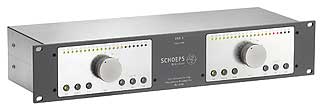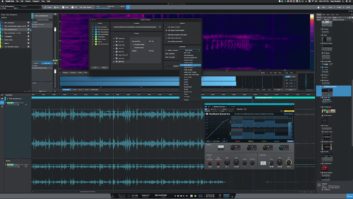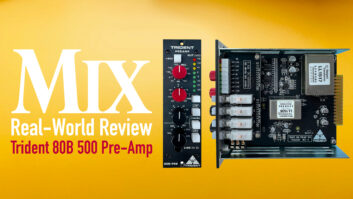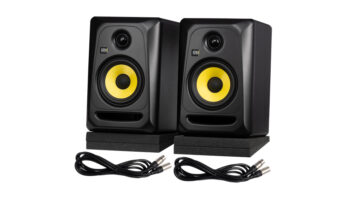
Top: The VSR 5 features six function buttons for phantom power, polarity, mute and three low-cut filters.
The VSR 5 is Schoeps’ commercial version of its custom test mic preamp with essentially the same circuitry: two independent preamp circuits in the same chassis with a common power supply. Although tight-lipped about what’s actually in the Core SVM amplifier modules, Schoeps was inspired by the TransAmp LZ modules from Valley People, famous for its low-noise circuits. With its rugged steel chassis and gray Nextel-finished front panel, the unit continues the impressive look and feel of Schoeps’ mic line.
High-End Design
The VSR 5 has a no-nonsense, uncluttered layout with the basic essentials. Each input section has easily viewable, fast-acting LEDs displaying overall gain from -48 dB to +9 dB, with a clip indicator at 20 dB. Firm detented stepped gain controls offer up to 60 dB of gain in 3dB increments. These are solid and don’t easily slip; you know when you’re making a change — no accidental bumping will happen with these.
Each channel has six function buttons, including lighted phantom, phase reverse and mute switches and three low-cut (40, 80 and 120Hz) settings.
Two very handy features include automatic sensing of condenser microphones (yellow for power-up and green for active on the phantom 48-volt switch) and automatic muting. Internal relay-controlled muting occurs whenever the unit is powered on/off — ideal for accidental power interruptions — and whenever phantom power is applied to either channel.

Interior view of the VSR 5, with power-supply transformers at top/center.
Rear audio connections include gold-plated XLR in/out and two 50-ohm balanced/floating independent outputs per channel. This is another handy feature, with one output set for direct monitoring and the other for an independent feed to an A/D converter or other recording device.
Life on the Inside
Popping the top reveals a sturdy, well-laid-out design. A center steel reinforcement panel prevents any chassis flexing. Metal standoffs provide extra circuit board and component reinforcement, with multicolored, flat-wire connectors from module to module — very nice. (All circuit boards are modular for easier service.) Each channel is physically separate and discrete, with its own Core SVM module. Gold-plated contacts on the XLRs and input trim pot contact (with precision resistors setting each gain step) ensure long-term, noise-free use. The power supply has three custom toroidal transformers, tested for lowest electromagnetic fields. The rear panel has a 120/230VAC operation switch, detachable AC cable socket and a three-position ground-lift switch (ground, lift and hi-Z).
In the Studio and Beyond
I used the VSR 5 on a near-daily basis on numerous projects. It’s recommended for studio use, but was very much at home and performed admirably in my live/remote recording rig, directly interfaced with a variety of digital I/O boxes, in most cases through an RME Fireface 800. In a wide range of sources — from classical piano to jazz vocal to operatic casts to larger and small orchestral ensembles — the VSR 5 effortlessly handled everything in its path.
First up was a performance of the rarely performed piano monster-piece “Hexameron” (Bellini/Liszt) with the Philadelphia Classical Symphony and pianist Kenneth Hamilton on a 9-foot New York Steinway grand, arguably one of the loudest works in the piano repertoire. With a pair of DPA 4023 mics inside the piano, this initial test showed just how much headroom and smooth, clean gain — especially in such a highly percussive and punishing environment — the VSR 5 circuitry offers. Any concerns about overload or pinched sound were quickly abated. I deliberately drove this particular piece the hardest, expecting to find some harshness or limits. Essentially, there were none until driven into clipping at the +51 mark on the input dial.
Next was a live recording of Chicago-based jazz vocalist Kurt Elling in Philadelphia’s Kimmel Center for a delayed radio broadcast. Taking a direct feed from a Shure Beta 57, the VSR 5 captured all of Elling’s nuances and far-ranging details, from scat to crooning, bopping and bellowing, even some near-whispered poetry recitation. I was glad to have the VSR 5 onboard for this one; the result was stunning and the broadcast turned out to be a real keeper.
A variety of other demanding projects quickly followed: stereo ORTF vocal pairs on operatic and choral performances with Audio-Technica 4050s; large ensemble orchestral mains with DPA 4006s; solo spot mics with vintage Neumann KMi-84s; and a U87 male voice-over session for ice-skating and holiday announcements at nearby Longwood Gardens.
The VSR 5 also proved useful with various ribbon mics (Cascade Fathead, AEA R-84, etc.), with more than enough clean gain to get the job done. The front panel defeatable phantom switch was a welcome option for safety’s sake.
Sonic Superstar
While touted as an in-studio device (and at $3,499, understandably so), the VSR 5 will find a home with those who want to invest in something at the same quality level and cost as Grace, Millennia, D.W. Fearn and other high-end preamps. Few may have the luxury of using the VSR 5 on remote recordings, yet it’s equally suitable for on-location work. Its solid build is much better than many other so-called “live” units I’ve seen, and with reasonable care the VSR 5 could easily be the main stereo pair pre of choice for audiophile location recording or broadcasting. The unit’s clean, uncolored gain, with all the basics and a few additional handy features (including excellent RF rejection), make it one serious contender in either setting — live or studio.
Joe Hannigan’s company, Weston Sound, is in its 21st year of production.

Click the Product Summary box to view the product page







